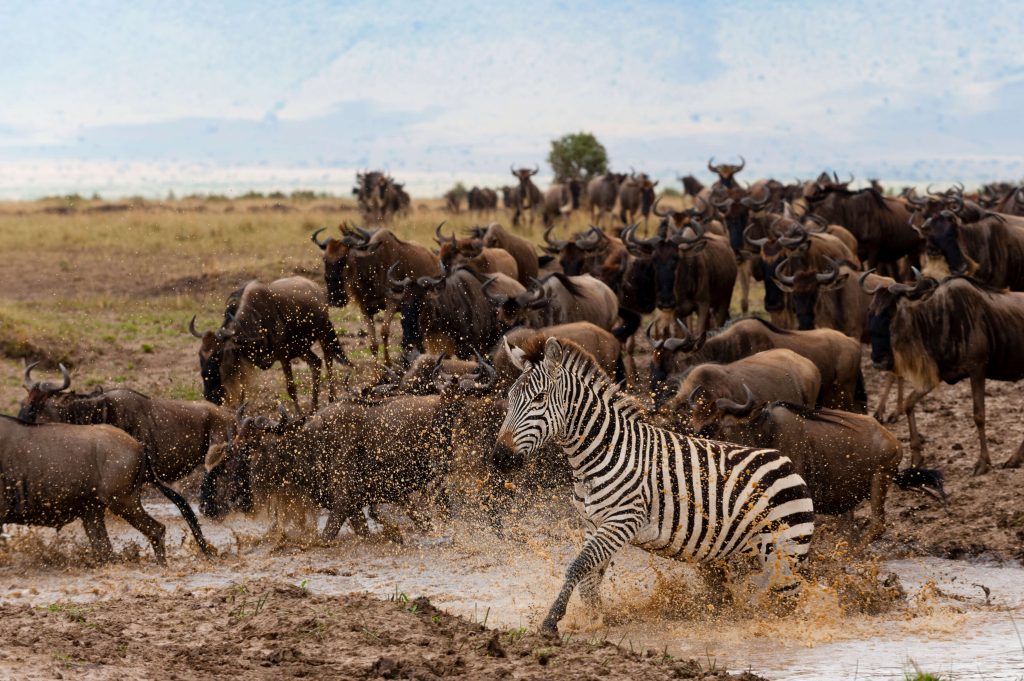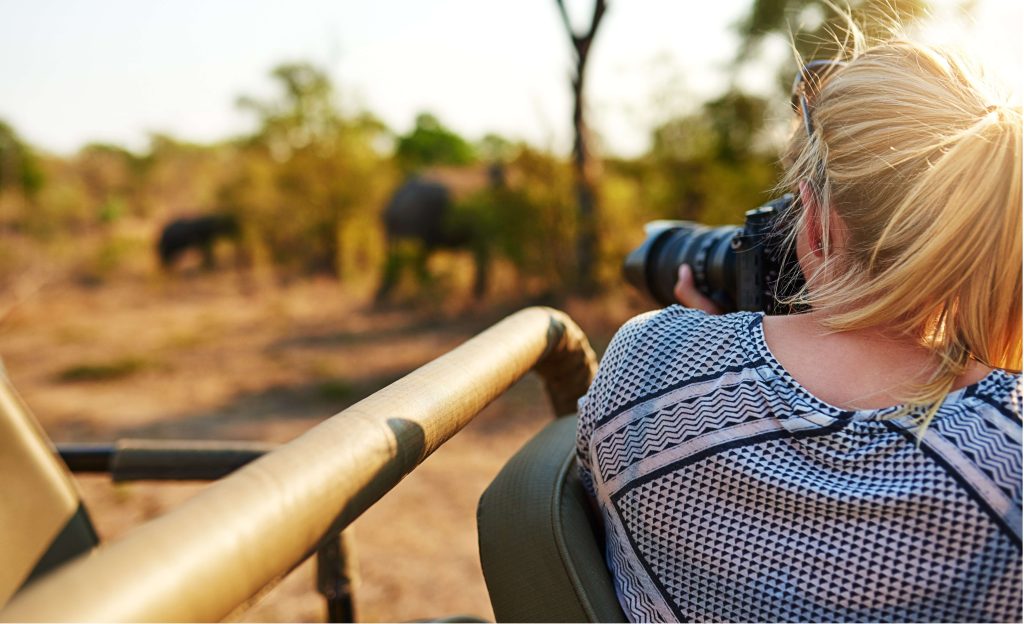Tourism, whether sustainable or not, shapes economies, ecosystems, and local futures. In Africa, it supports an estimated 24.7 million jobs across the continent, according to 2023 UNWTO data.
Where money flows directly affects the survival of wildlife corridors, the health of marine reserves, and the long-term viability of rural livelihoods. Each itinerary creates ripple effects.
The climate clock is also moving fast. Shifting rainfall patterns in northern Namibia are straining community-managed conservancies. Along Ghana’s coastline, sea-level rise and erosion have altered entire fishing villages. In Kenya’s Maasai Mara, warmer temperatures are already changing migratory behaviour.

Travel can put pressure on these systems. Structured properly, it can also reinforce them.
At Inmersion Africa Journeys, sustainable tourism and travel fuels how we build every trip. We align each journey with low-impact design, fair economic flow, and local collaboration.
The model depends on strong community partnerships and environmental integrity at every level, from the field to the boardroom.
By early 2024 (January to April), East Africa was receiving nearly 90 per cent of its pre-2020 international arrivals. This is based on regional data from the African Development Bank.
That rebound brings financial opportunity, but without a clear structure, it risks overwhelming fragile areas. It is vital to note that scale and sustainability in tourism need to grow together and not separately.
Sustainable tourism is a working framework. It guides how to protect ecosystems, support self-determination, and build lasting value from travel.
If you’re reading this, you’re probably weighing more than destinations. You’re thinking about the impact you want to leave behind. That’s where real planning begins.
The Inmersion Africa Ethos
At Inmersion Africa Journeys, we start every trip with one priority: to create lasting value for the people and ecosystems that make travel possible.
We build each itinerary in coordination with regional partners. These include local guides, conservationists, researchers, and entrepreneurs. No trip comes off a shelf, as every detail supports a broader purpose of sustainable travel.
This structure runs deep. Our teams operate directly in places like the Chyulu Hills in Kenya, Nkhotakota Wildlife Reserve in Malawi, and the upper Zambezi corridor in Zambia.
These regions depend on responsible/sustainable tourism planning to fund conservation, expand local incomes, and keep decision-making rooted in the community.
We partner with community conservancies, family-operated lodges, and national parks that invest in long-term environmental stability. These relationships don’t exist for optics. They drive better results. Local guides add depth. Revenue stays on-site. Natural areas gain active protection.
In addition, we set strict group size limits. Smaller groups reduce ecological strain and allow for deeper exchanges. That might include a day with a Lozi canoe-builder on the Barotse floodplain or a hands-on lesson in indigenous fire control methods in Niassa. We cut the filters. Knowledge flows from source to visitor without dilution.
If you’re thinking about how tourism infrastructure shapes outcomes, you’re asking the right questions. We don’t run packaged trips. We build systems and we hold them accountable across seasons, regions, and generations.
Sustainability in Practice
Sustainable travel is the operational foundation behind every trip we design.
From job creation to waste management, every component has to pull in the same direction. The following pillars show how we put this into motion across different regions.
A. Supporting Local Economies
In every location we work, we hire directly and prioritise local enterprise. Guides, chefs, drivers, porters and other members of our teams live in the areas you travel through. This keeps revenue circulating where it’s earned.
We focus on independently owned camps and lodges. In Tsavo West, Kenya, one of our partner properties directs 60 per cent of net revenue to a Maasai-managed conservation fund. That fund finances water access points and corridor monitoring.
We also back skills development programs. In 2024, we co-funded a training initiative in northern Botswana that certified 26 young people in bush guiding, field logistics, and species identification. Some now work with our operational teams. Others have launched their services.
B. Conservation-Integrated Operations
Tourism only works long-term when conservation stands at the centre. We build every itinerary in direct coordination with protected areas, conservancies, and wildlife trusts. Each booking carries a built-in conservation fee or contribution, with full transparency on where it goes.
In Nkhotakota, Malawi, a fixed per-night conservation fee supports ranger patrols, camera trap maintenance, and vegetation surveys. Lodges are selected based on tangible metrics: solar energy systems, closed-loop waste treatment, and ecological buffer zoning. Several support rewilding programs and maintain real-time tracking on species movement.
Besides funding, we incorporate conservation into the guest experience. Visitors spend time with rangers, researchers, and park planners. In Liwonde National Park, one of our 2023 groups joined a field team collecting data for a predator-prey dynamics study. These aren’t staged excursions. They’re operational realities.
C. Cultural Respect and Co-Creation
Cultural experience is a process shared on equal terms. We design programs with, not for, the communities involved.
In Zambia’s Western Province, we collaborated with Lozi educators and elders to structure an oral history sequence for every journey. It includes storytelling, shared meals, and access to traditional land court discussions.
There’s no performance. What’s offered comes from within the community.
In addition, we prepare visitors with linguistic and cultural briefings at the start of each trip. These cover greetings, protocol, key history, and regional context.
A little groundwork goes a long way toward mutual respect.
D. Reducing Environmental Impact
Our logistics model limits footprint wherever possible. We avoid short-hop flights, reduce transfer frequency, and work with operators adapting vehicles for cleaner performance.
In Uganda and Tanzania, our partners have outfitted solar-assist hybrid safari vehicles using locally modified systems.
We eliminate single-use plastic at every point in the supply chain. All provisioning relies on refillable water systems, biodegradable hygiene kits, and regional food sourcing.
There are no flown-in packaged snacks, and no bottled water.
We also recommend that guests support verified forest restoration projects in Rwanda and Mozambique. While offsetting has limits, it helps stabilise areas undergoing pressure. More importantly, we promote structural change: fewer moves, longer stays, deeper investment.
Travel leaves a trace. Our work is about shaping that trace so it strengthens the systems it touches.
The Strategic Value of Sustainability to Tourism
Tourism dominates policy, land use, and capital movements. It provides more than 24 million Africans with employment and more than 7 per cent of the continent’s GDP.
It is the only connection between the ecological resource base and economic infrastructure in some rural areas.
When developed on a sustainable basis, tourism can stabilise natural systems, promote community-based governance, and propel national development priorities. This matters at extended levels.
Sustainable tourism invests funds into conservation trust funds, local ownership schemes, and capacity-building programs whose benefits last longer than any one visit. Every activity contributes to a system.
Inmersion Africa’s operations align with specific global frameworks. These include the UN Sustainable Development Goals, particularly Goal 8 on decent work, Goal 12 on responsible production, and Goal 15 on protecting terrestrial ecosystems. Our programs support verified conservation areas, community employment targets, and direct investment into operational zones.
Aside from the environmental gains, there are actual policy ramifications. Conservation parks linked to tourism in most of Zambia and Malawi are real barriers to the invasion by extractive industries.
In Uganda, locals’ lodges support borehole systems and solar panels independently of donors. These are instances of how tourism can finance local agendas and wean nations off aid dependence.
You might be considering places and destinations. But what lies behind every travel plan is a network of choices: who is employed, where money flows, whose land is guarded, and whose wisdom is honoured. If we are to think about sustainable tourism as infrastructure, it pays dividends far beyond the end of the travel plan.
Join Us in Travelling Differently
Tourism decisions carry structural consequences. They influence how natural resources are managed, how institutions are financed, and how communities exercise control over what is shared, built, and protected.
Each itinerary will definitely involve a set of choices that either reinforce existing systems or redirect their trajectory.
Where visitors go, how they move, who they interact with, and what models those interactions support: all of this shapes the outcomes tourism produces. Planning responsibly means understanding that your presence is part of a larger framework, even before you arrive.
There is a growing expectation among serious travellers, sector partners, and public stakeholders that tourism should function with measurable integrity.
It should rely on clear standards, local involvement, and outcomes that extend beyond individual experience. This is no longer a niche conversation. It defines how the sector will hold up under changing political, environmental, and economic conditions.

We invite you to approach your next journey through that lens. If your priorities include system-level thinking, long-term value creation, and credible partnership with local actors, we are prepared to work with you.
Our team will engage with your objectives, answer your questions, and offer direct insight into what is possible and required for travel to deliver meaningful outcomes.
To begin that conversation, contact our team through the platform or request a detailed consultation.
